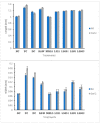Antiobesity and Antioxidative Effect of Fermented Brown Rice Using In Vitro with In Vivo Caenorhabditis elegans Model
- PMID: 36836733
- PMCID: PMC9963734
- DOI: 10.3390/life13020374
Antiobesity and Antioxidative Effect of Fermented Brown Rice Using In Vitro with In Vivo Caenorhabditis elegans Model
Abstract
Naturally occurring phytochemicals from plants or grains are crucial in reducing various metabolic disorders. Bioactive phytonutrients are abundant in the Asian dietary staple, brown rice. This research evaluated the impact of lactic acid bacteria (LABs) bioconversion and fermentation on antioxidant and antiobesity activities and ferulic acid content in brown rice. The combination of bioconversion with Pediococcus acidilactici MNL5 among all LABs used showed a synergistic impact with 24 h of solid-state brown rice fermentation. The 24-h MNL5 fermented brown rice (FBR) demonstrated the most potent pancreatic lipase inhibitory activity (85.5 ± 1.25%) compared to raw brown rice (RBR) (54.4 ± 0.86%). The antioxidant potential of MNL5-FBR was also found to be highest in the DPPH assay (124.40 ± 2.40 mg Trolox Equiv./100 g, DW), ABTS assay (130.52 ± 2.32 mg Trolox Equiv./100 g, DW), and FRAP assay (116.16 ± 2.42 mg Trolox Equiv./100 g, DW). Based on higher antioxidant and antiobesity activities, samples were quantified for ferulic acid content using the HPLC-MS/MS approach. Furthermore, C. elegans supplementation with FBR showed enhanced life span and lipid reduction in fluorescence microscope analysis compared to the control. Our results indicate that the expression study using the C. elegans model (N2 and Daf-2 models) fat gene was conducted, showing a lowering of obesity ability in FBR-fed worms. Our study indicates that FBR has improved antioxidant and antiobesity actions, especially in MNL5-FBR, and can be employed to develop functional foods that combat obesity.
Keywords: Pediococcus acidilactici MNL5; brown rice; ferulic acid; lipase inhibitory; lipid reduction.
Conflict of interest statement
The authors declare no conflict of interest.
Figures







Similar articles
-
Untargeted metabolomics-based network pharmacology reveals fermented brown rice towards anti-obesity efficacy.NPJ Sci Food. 2024 Mar 30;8(1):20. doi: 10.1038/s41538-024-00258-x. NPJ Sci Food. 2024. PMID: 38555366 Free PMC article.
-
Limosilactobacillus reuteri Fermented Brown Rice: A Product with Enhanced Bioactive Compounds and Antioxidant Potential.Antioxidants (Basel). 2021 Jul 5;10(7):1077. doi: 10.3390/antiox10071077. Antioxidants (Basel). 2021. PMID: 34356310 Free PMC article.
-
Untargeted Metabolomics and Gut Microbiota Modulation Study of Fermented Brown Rice for Obesity.ACS Omega. 2024 Aug 28;9(36):37636-37649. doi: 10.1021/acsomega.4c01203. eCollection 2024 Sep 10. ACS Omega. 2024. PMID: 39281900 Free PMC article.
-
Phytochemical Profile of Brown Rice and Its Nutrigenomic Implications.Antioxidants (Basel). 2018 May 23;7(6):71. doi: 10.3390/antiox7060071. Antioxidants (Basel). 2018. PMID: 29789516 Free PMC article. Review.
-
In vitro and in vivo antioxidant potential of milks, yoghurts, fermented milks and cheeses: a narrative review of evidence.Nutr Res Rev. 2018 Jun;31(1):52-70. doi: 10.1017/S0954422417000191. Epub 2017 Oct 2. Nutr Res Rev. 2018. PMID: 28965518 Review.
Cited by
-
Composition, Microbiota, Mechanisms, and Anti-Obesity Properties of Rice Bran.Foods. 2023 Mar 18;12(6):1300. doi: 10.3390/foods12061300. Foods. 2023. PMID: 36981226 Free PMC article. Review.
-
Impact of Molecular Weight Variations in Dendrobium officinale Polysaccharides on Antioxidant Activity and Anti-Obesity in Caenorhabditis elegans.Foods. 2024 Mar 28;13(7):1040. doi: 10.3390/foods13071040. Foods. 2024. PMID: 38611346 Free PMC article.
References
-
- World Health Organization World Obesity Day 2022–Accelerating Action to Stop Obesity. 2022. [(accessed on 22 December 2022)]. Available online: https://www.who.int/news/item/04-03-2022-world-obesity-day-2022-accelera....
-
- Mohan V., Ruchi V., Gayathri R., Ramya Bai M., Shobana S., Anjana R., Unnikrishnan R., Sudha V. Brown Rice. Springer; Berlin/Heidelberg, Germany: 2017. Hurdles in brown rice consumption; pp. 255–269.
-
- Ohsaki Y., Shirakawa H., Koseki T., Komai M. Novel effects of a single administration of ferulic acid on the regulation of blood pressure and the hepatic lipid metabolic profile in stroke-prone spontaneously hypertensive rats. J. Agric. Food Chem. 2008;56:2825–2830. - PubMed
Grants and funding
LinkOut - more resources
Full Text Sources
Miscellaneous

